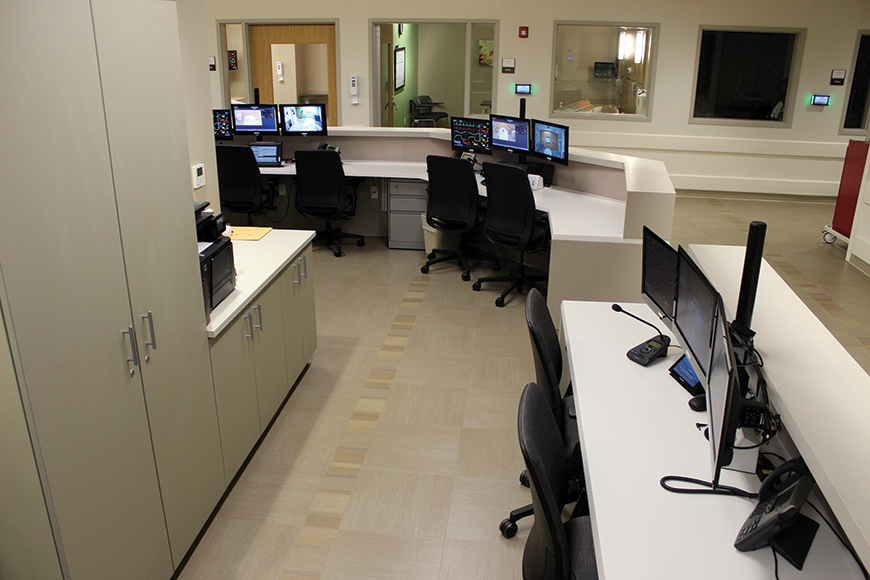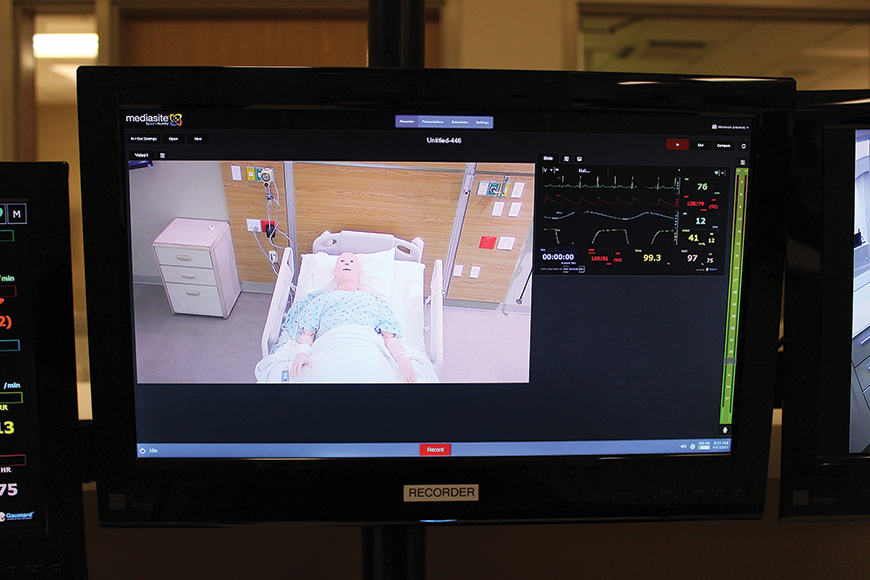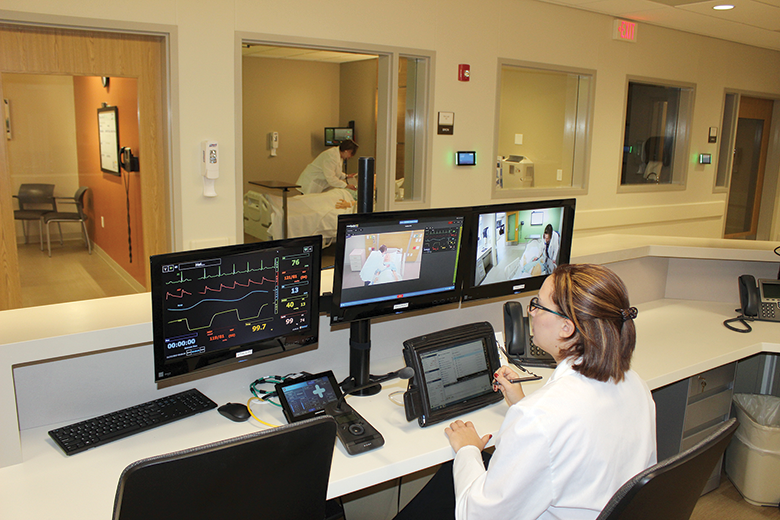TIPS
>> Ensure multicast capability to handle the demands of AV on an IT infrastructure.
>> Use USB extension to provide KVM-like capabilities without dedicated wiring.
>> In medical AV, confirm your switching and distribution platform delivers both low latency and pristine video quality.
The Blessing Health System is a visible part of the fabric in the small Midwestern city of Quincy IL. In addition to the 307-bed Blessing Hospital and the charitable, community-focused support system that comprises the Blessing Foundation, the growing healthcare organization offers a range of educational programs and training services at its own private college.
Situated close to Blessing Hospital, the Blessing-Rieman College of Nursing & Health Sciences has been offering these programs and services for more than 125 years. To accommodate its own growth, the college recently relocated to a building on 11th and Oak in downtown Quincy.

As often happens in these situations, the organization wanted to salvage some of its existing AV equipment, integrating those components with new technologies that would better complement today’s more digitally focused learning environments. Southwest Audio-Visual, a Springfield MO-based systems design and integration firm that also specializes in AV equipment sales, was hired to achieve that delicate balance in the new facility’s educational crown jewel: The Simulation Center.
A New Path
The Simulation Center at Blessing-Rieman is a complete hospital unit that has nine patient rooms and five control stations, and it’s where students are offered specialized instruction and a sophisticated learning environment to master clinical skills. This includes working with male, female and pediatric manikins programmed to mimic medical complications.

Working with an existing structure, the construction team hired by the college handled the complete teardown of existing infrastructure, leaving little behind but walls and the electrical systems. We came into a clean facility with a fresh set of system design plans to merge a networked architecture for video and control signals, driven by Atlona and Crestron, and to establish a separate hybrid IP and legacy wired system for audio, powered by Biamp.
The college opted for an isolated network to support AV systems, chiefly to work around privacy laws and other restrictions associated with Blessing Hospital’s main network. We established a multicast-capable network leveraging off-the-shelf Cisco SG300-52MP managed switches to ensure the video and control equipment could live and operate on the IT infrastructure, alongside internet and other data traffic.
The primary driver that took us down the IP path started with, perhaps unusually, the switch frame size. The previous analog AV infrastructure was limited to a 32×32 chassis that was long maxed out, and most digital fixed-frame systems offer the same capacity. It was clear that the new facility would be limited by a 32×32 infrastructure, as the college intends to add more rooms within The Simulation Center in the coming years. The next natural option was an upgrade to a 64×64 fixed-frame system. Although these were readily available, budget constraints removed that option from the table.
With a feasible IT infrastructure of network cabling and switches in place, and plenty of bandwidth, we set our sights on the quickly evolving universe of AV-over-IP. However, because it is an emerging approach to applying AV technology, particularly on the video side, we had our share of concerns. Would the system be reliable? What trade-offs would there be as regards signal latency and overall quality?
Our search eventually led us to Atlona’s OmniStream platform to power all switching and distribution over the network, with clean integration to a Crestron AV3 control system. The OmniStream frame architecture was also flexible enough to fulfill our needs without the extra costs and unused capacity that we’d have been handed with a larger 64×64 frame.
Building Bridges
The control stations represent the central activity of the technical infrastructure. At these locations, instructors monitor two camera views and the vital signs of each manikin across three displays. Each patient room features an Axis M3045 fixed model at the head of the bed, looking downward at the manikin, and an Axis V5915 PTZ model across the room, which can be controlled over Crestron. Based on a script of triggers, the instructor can initiate symptoms, such as elevated pulse and plummeting blood pressure. The student at the control station must diagnose and react to the changing medical conditions.
Using two-way audio connectivity, students in the patient room speak to the “patient.” Voice is captured over Shure MX202WP/C ceiling microphones and transmitted to the nurse’s station over an IP-enabled Biamp AudiaFLEX CM frame.
Instructors listen to the diagnoses over beyerdynamic DT109 headsets, powered by RDL ST-SH1 headphone amplifiers, and they respond over the bi-directional Biamp IP audio link using Biamp NPS1 paging stations on the desk surface to patient room overhead 70V AtlasIED FAP42T speakers. The paging stations offer all-call and zoned paging, and simulation of large-scale events—such as a “code blue”—is also possible.
Although the Biamp architecture provides IP transport of audio over CobraNet between the nine patient rooms, five control stations and operating room (OR) simulation room, OmniStream paved the way for cleanly transitioning all video sources and destinations to the school’s dedicated IT network. The complete OmniStream installation includes 18 encoders (10 OMNI-111 single-channel and 10 OMNI-112 dual-channel models) and 18 decoders (12 OMNI-121 single-channel and seven OMNI-122 dual-channel decoders). With two inputs and two network connections, the dual-channel models offer the flexibility to reduce the stream size to preserve network bandwidth, yet retain 1080p quality.
In each of the nine patient rooms, the OMNI-112 dual-channel encoders natively accept the Axis camera HDMI feeds, and distribute them to a Sonic Foundry MediaSite server for playout over generic computers. In most rooms, the computers output the video content into the HDMI input of an OMNI-111 single-channel encoder, which places the video on the Cisco switch. That content is then moved to the OMNI-121 and OMNI-122 decoders, which output the HDMI signals to 19-inch generic video monitors.
At each control station, instructors can use Crestron TSW-760-B-S touchpanels to manipulate Axis PTZ camera movements, such as zooming into an IV pump or a manikin’s face. A separate OR simulation room includes two Axis PTZ cameras for this purpose, and excludes the fixed camera.
No Patience Required
OmniStream eliminated the latency concerns of point-to-point transmission of 1080p video between patient rooms and control stations immediately on deployment. (4K/ultra HD sources are supported on OmniStream and they remain in consideration; the current cameras and recorders top out at 1080p.) With sub-frame latency, video moves seamlessly over the network even as switches resynchronize to accommodate new video sources.
That speed allows us to mirror the analog functionality of the old system that users were accustomed to enjoying with virtually no delay upon source switching. That’s compared to other IP-based HDMI switching systems that took between five and 10 seconds to relock signals upon switching. Instead, students see the Axis camera angles in near real-time, without blockiness or degradation in resolution, and no reactive delay in mouse clicks and keyboard strokes as students work with video sources.
Crestron USB extenders provide an additional efficiency boost. With its matrix-like approach, users can match a send and receive point in real time using commands from the AV3 system. That’s especially useful for the one-touch PCs showing vital signs in each space. The PCs are wall-mounted, and they have a corresponding keyboard and mouse on the control desk. This provides a KVM-like operability over the network, without the traditional dedicated wiring.
All audio and video sessions are recorded into a Sonic Foundry Mediasite RL HD digital recording system. The system includes multiple inputs to ingest content, which then automatically uploads to a MediaSite EX server. This cloud-based approach ensures that instructors and students are easily able to review educational content at a later date.
The technical infrastructure in place today will accommodate growth (and, when required, signal redundancy) without issue as new rooms are added and more components are needed. Two additional patient rooms have been carved out that will be added to the network at a later date, and expansion channels exist in the Atlona, Biamp and Crestron systems. Omni-Stream itself can grow until switch capacity is reached, which will take many years. In fact, as both Axis cameras combine into an OMNI-112 dual-channel encoder to utilize a single network drop, with two wires in place for future expandability, the overall switch count was minimized. This architecture required less network infrastructure and half the hardware, and it ensures that all transmitting and receiving devices can perform double duty over a single network connection. That’s an ideal blueprint to build on as the facility grows.
Overcoming the initial challenges related to frame size and the convergence of new and existing systems proved fairly simple in the end, and budget costs tied to labor and equipment were not exceeded. By adding new touches, such as USB extension, the Blessing-Rieman College of Nursing & Health Sciences has a fully functioning medical AV system that delivers the exceptional video quality and low signal latency that the vertical market requires, along with a robust network infrastructure made stronger through its multicast configuration.
Key Components
18 AtlasIED FAP42T ceiling speakers
10 Atlona OmniStream OMNI-111 encoders
10 Atlona OmniStream OMNI-112 decoders
12 Atlona OmniStream OMNI-121 encoders
7 Atlona OmniStream OMNI-122 decoders
7 Axis M3045-V cameras
9 Axis V5915 PTZ cameras
4 beyerdynamic DT109 headsets with mics
1 Biamp AudiaFLEX CM frame
4 Biamp NPS1 paging stations
2 Cisco SG300-52MP 52-port Gigabit Max-PoE managed switches
1 Crestron AV3 control system
4 Crestron TSW-760-B-S 7″ touchpanels
4 Crestron TSW-760-TTK tabletop kits for TSW-760
10 Crestron USB-EXT-DM-REMOTE Ethernet extenders, host modules
14 Crestron USB-EXT-DM-REMOTE Ethernet extenders,
4-port device modules
60 CTG 35219 Cat6 RJ45 UTP tool-less keystone jacks
2 RapcoHorizon audio signal cables, 2,000′
4 RDL PS24 power supplies
4 RDL ST-SH1 headphone amps
9 Shure MX202WP/C ceiling mics
1 Sonic Foundry Mediasite EX server
2 Sonic Foundry Mediasite RL HD digital recording systems
1 SurgeX SX2120 power conditioner
2 Wirepath 14/2 speaker cables, 2,000′
6 Wirepath unshielded 550MHz 23/4 solid .57mm Cat6 wire
